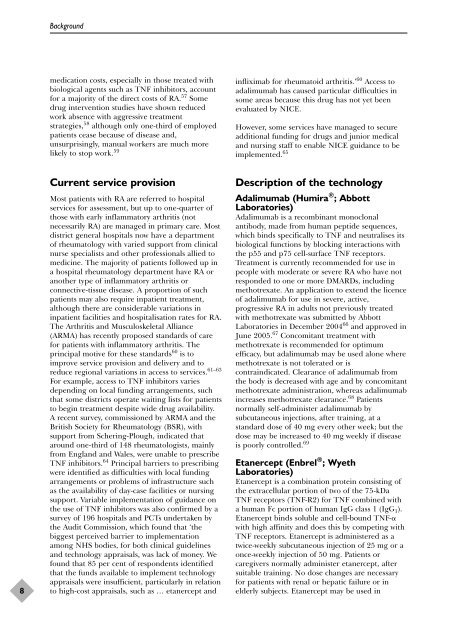A systematic review of the effectiveness of adalimumab
A systematic review of the effectiveness of adalimumab
A systematic review of the effectiveness of adalimumab
Create successful ePaper yourself
Turn your PDF publications into a flip-book with our unique Google optimized e-Paper software.
8<br />
Background<br />
medication costs, especially in those treated with<br />
biological agents such as TNF inhibitors, account<br />
for a majority <strong>of</strong> <strong>the</strong> direct costs <strong>of</strong> RA. 57 Some<br />
drug intervention studies have shown reduced<br />
work absence with aggressive treatment<br />
strategies, 58 although only one-third <strong>of</strong> employed<br />
patients cease because <strong>of</strong> disease and,<br />
unsurprisingly, manual workers are much more<br />
likely to stop work. 59<br />
Current service provision<br />
Most patients with RA are referred to hospital<br />
services for assessment, but up to one-quarter <strong>of</strong><br />
those with early inflammatory arthritis (not<br />
necessarily RA) are managed in primary care. Most<br />
district general hospitals now have a department<br />
<strong>of</strong> rheumatology with varied support from clinical<br />
nurse specialists and o<strong>the</strong>r pr<strong>of</strong>essionals allied to<br />
medicine. The majority <strong>of</strong> patients followed up in<br />
a hospital rheumatology department have RA or<br />
ano<strong>the</strong>r type <strong>of</strong> inflammatory arthritis or<br />
connective-tissue disease. A proportion <strong>of</strong> such<br />
patients may also require inpatient treatment,<br />
although <strong>the</strong>re are considerable variations in<br />
inpatient facilities and hospitalisation rates for RA.<br />
The Arthritis and Musculoskeletal Alliance<br />
(ARMA) has recently proposed standards <strong>of</strong> care<br />
for patients with inflammatory arthritis. The<br />
principal motive for <strong>the</strong>se standards 60 is to<br />
improve service provision and delivery and to<br />
reduce regional variations in access to services. 61–63<br />
For example, access to TNF inhibitors varies<br />
depending on local funding arrangements, such<br />
that some districts operate waiting lists for patients<br />
to begin treatment despite wide drug availability.<br />
A recent survey, commissioned by ARMA and <strong>the</strong><br />
British Society for Rheumatology (BSR), with<br />
support from Schering-Plough, indicated that<br />
around one-third <strong>of</strong> 148 rheumatologists, mainly<br />
from England and Wales, were unable to prescribe<br />
TNF inhibitors. 64 Principal barriers to prescribing<br />
were identified as difficulties with local funding<br />
arrangements or problems <strong>of</strong> infrastructure such<br />
as <strong>the</strong> availability <strong>of</strong> day-case facilities or nursing<br />
support. Variable implementation <strong>of</strong> guidance on<br />
<strong>the</strong> use <strong>of</strong> TNF inhibitors was also confirmed by a<br />
survey <strong>of</strong> 196 hospitals and PCTs undertaken by<br />
<strong>the</strong> Audit Commission, which found that ‘<strong>the</strong><br />
biggest perceived barrier to implementation<br />
among NHS bodies, for both clinical guidelines<br />
and technology appraisals, was lack <strong>of</strong> money. We<br />
found that 85 per cent <strong>of</strong> respondents identified<br />
that <strong>the</strong> funds available to implement technology<br />
appraisals were insufficient, particularly in relation<br />
to high-cost appraisals, such as … etanercept and<br />
infliximab for rheumatoid arthritis.’ 60 Access to<br />
<strong>adalimumab</strong> has caused particular difficulties in<br />
some areas because this drug has not yet been<br />
evaluated by NICE.<br />
However, some services have managed to secure<br />
additional funding for drugs and junior medical<br />
and nursing staff to enable NICE guidance to be<br />
implemented. 65<br />
Description <strong>of</strong> <strong>the</strong> technology<br />
Adalimumab (Humira ® ; Abbott<br />
Laboratories)<br />
Adalimumab is a recombinant monoclonal<br />
antibody, made from human peptide sequences,<br />
which binds specifically to TNF and neutralises its<br />
biological functions by blocking interactions with<br />
<strong>the</strong> p55 and p75 cell-surface TNF receptors.<br />
Treatment is currently recommended for use in<br />
people with moderate or severe RA who have not<br />
responded to one or more DMARDs, including<br />
methotrexate. An application to extend <strong>the</strong> licence<br />
<strong>of</strong> <strong>adalimumab</strong> for use in severe, active,<br />
progressive RA in adults not previously treated<br />
with methotrexate was submitted by Abbott<br />
Laboratories in December 2004 66 and approved in<br />
June 2005. 67 Concomitant treatment with<br />
methotrexate is recommended for optimum<br />
efficacy, but <strong>adalimumab</strong> may be used alone where<br />
methotrexate is not tolerated or is<br />
contraindicated. Clearance <strong>of</strong> <strong>adalimumab</strong> from<br />
<strong>the</strong> body is decreased with age and by concomitant<br />
methotrexate administration, whereas <strong>adalimumab</strong><br />
increases methotrexate clearance. 68 Patients<br />
normally self-administer <strong>adalimumab</strong> by<br />
subcutaneous injections, after training, at a<br />
standard dose <strong>of</strong> 40 mg every o<strong>the</strong>r week; but <strong>the</strong><br />
dose may be increased to 40 mg weekly if disease<br />
is poorly controlled. 69<br />
Etanercept (Enbrel ® ; Wyeth<br />
Laboratories)<br />
Etanercept is a combination protein consisting <strong>of</strong><br />
<strong>the</strong> extracellular portion <strong>of</strong> two <strong>of</strong> <strong>the</strong> 75-kDa<br />
TNF receptors (TNF-R2) for TNF combined with<br />
a human Fc portion <strong>of</strong> human IgG class 1 (IgG 1).<br />
Etanercept binds soluble and cell-bound TNF-<br />
with high affinity and does this by competing with<br />
TNF receptors. Etanercept is administered as a<br />
twice-weekly subcutaneous injection <strong>of</strong> 25 mg or a<br />
once-weekly injection <strong>of</strong> 50 mg. Patients or<br />
caregivers normally administer etanercept, after<br />
suitable training. No dose changes are necessary<br />
for patients with renal or hepatic failure or in<br />
elderly subjects. Etanercept may be used in
















